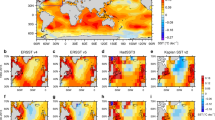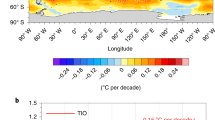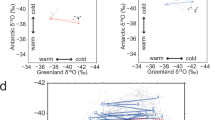Abstract
Despite global warming, a region in the North Atlantic ocean has been observed to cool, a phenomenon known as the warming hole. Its emergence has been linked to a slowdown of the Atlantic meridional overturning circulation, which leads to a reduced ocean heat transport into the warming hole region. Here we show that, in addition to the reduced low-latitude heat import, increased ocean heat transport out of the region into higher latitudes and a shortwave cloud feedback dominate the formation and temporal evolution of the warming hole under greenhouse gas forcing. In climate model simulations of the historical period, the low-latitude Atlantic meridional overturning circulation decline does not emerge from natural variability, whereas the accelerating heat transport to higher latitudes is clearly attributable to anthropogenic forcing. Both the overturning and the gyre circulation contribute to the increased high-latitude ocean heat transport, and therefore are critical to understand the past and future evolutions of the warming hole.
This is a preview of subscription content, access via your institution
Access options
Access Nature and 54 other Nature Portfolio journals
Get Nature+, our best-value online-access subscription
$29.99 / 30 days
cancel any time
Subscribe to this journal
Receive 12 print issues and online access
$209.00 per year
only $17.42 per issue
Buy this article
- Purchase on Springer Link
- Instant access to full article PDF
Prices may be subject to local taxes which are calculated during checkout






Similar content being viewed by others
Data availability
HadCRUT4 data were provided by the UK Met Office Hadley Centre (http://www.met-office.gov.uk/hadobs/hadcrut4/), as well as HadISST data (https://www.metoffice.gov.uk/hadobs/hadisst/). Data from the RAPID-WATCH MOC monitoring project are freely available from www.rapid.ac.uk/rapidmoc funded by the Natural Environment Research Council. The Grand Ensemble is publicly available at ESGF (https://esgf-data.dkrz.de/projects/esgf-dkrz/). The special simulations are available on request from the corresponding author.
Code availability
An archive with the bash, python and NCL scripts used to conduct the calculations that underlie this study and reproduce the figures is archived by the Max Planck Institute for Meteorology and can be accessed from the public repository of the Max Planck Society, https://pure.mpg.de/pubman/faces/ViewItemOverviewPage.jsp?itemId=item_3213979.
References
Seager, R. et al. Is the gulf stream responsible for Europe’s mild winters? Q. J. R. Meteorol. Soc. 128, 2563–2586 (2002).
Kaspi, Y. & Schneider, T. Winter cold of eastern continental boundaries induced by warm ocean waters. Nature 471, 621–624 (2011).
Stocker, T. F. & Wright, D. G. Rapid transitions of the ocean’s deep circulation induced by changes in surface water fluxes. Nature 351, 729–732 (1991).
Rahmstorf, S. Bifurcations of the Atlantic thermohaline circulation in response to changes in the hydrological cycle. Nature 378, 145–149 (1995).
Rahmstorf, S. et al. Exceptional twentieth-century slowdown in Atlantic Ocean overturning circulation. Nat. Clim. Change 5, 475–480 (2015).
Sévellec, F., Fedorov, A. V. & Liu, W. Arctic sea-ice decline weakens the Atlantic meridional overturning circulation. Nat. Clim. Change 7, 604–610 (2017).
Drijfhout, S., Van Oldenborgh, G. J. & Cimatoribus, A. Is a decline of AMOC causing the warming hole above the North Atlantic in observed and modeled warming patterns? J. Clim. 25, 8373–8379 (2012).
Menary, M. B. & Wood, R. A. An anatomy of the projected North Atlantic warming hole in CMIP5 models. Clim. Dynam. 50, 3063–3080 (2018).
Caesar, L., Rahmstorf, S., Robinson, A., Feulner, G. & Saba, V. Observed fingerprint of a weakening Atlantic Ocean overturning circulation. Nature 556, 191–196 (2018).
Gervais, M., Shaman, J. & Kushnir, Y. Mechanisms governing the development of the North Atlantic warming hole in the CESM-LE future climate simulations. J. Clim. 31, 5927–5946 (2018).
Laurian, A., Drijfhout, S., Hazeleger, W. & van den Hurk, B. Response of the Western European climate to a collapse of the thermohaline circulation. Clim. Dynam. 34, 689–697 (2010).
Haarsma, R. J., Selten, F. M. & Drijfhout, S. S. Decelerating Atlantic meridional overturning circulation main cause of future West European summer atmospheric circulation changes. Environ. Res. Lett. 10, 094007 (2015).
Gervais, M., Shaman, J. & Kushnir, Y. Impacts of the North Atlantic warming hole in future climate projections: mean atmospheric circulation and the North Atlantic jet. J. Clim. 32, 2673–2689 (2019).
Smeed, D. et al. Observed decline of the Atlantic meridional overturning circulation 2004–2012. Ocean Sci. 10, 29–38 (2014).
Jackson, L. C., Peterson, K. A., Roberts, C. D. & Wood, R. A. Recent slowing of Atlantic overturning circulation as a recovery from earlier strengthening. Nat. Geosci. 9, 518–522 (2016).
Maher, N. et al. The Max Planck Institute Grand Ensemble—enabling the exploration of climate system variability. J. Adv. Model. Earth Syst. 11, 2050–2069 (2019).
Booth, B. B., Dunstone, N. J., Halloran, P. R., Andrews, T. & Bellouin, N. Aerosols implicated as a prime driver of twentieth-century North Atlantic climate variability. Nature 484, 228–232 (2012).
Sutton, R. T., Dong, B. & Gregory, J. M. Land/sea warming ratio in response to climate change: IPCC AR4 model results and comparison with observations. Geophys. Res. Lett. 34, L02701 (2007).
Ceppi, P., McCoy, D. T. & Hartmann, D. L. Observational evidence for a negative shortwave cloud feedback in middle to high latitudes. Geophys. Res. Lett. 43, 1331–1339 (2016).
Trossman, D., Palter, J., Merlis, T., Huang, Y. & Xia, Y. Large-scale ocean circulation–cloud interactions reduce the pace of transient climate change. Geophys. Res. Lett. 43, 3935–3943 (2016).
Oldenburg, D., Armour, K. C., Thompson, L. & Bitz, C. M. Distinct mechanisms of ocean heat transport into the Arctic under internal variability and climate change. Geophys. Res. Lett. 45, 7692–7700 (2018).
Jungclaus, J. et al. Characteristics of the ocean simulations in the Max Planck Institute Ocean Model (MPIOM) the ocean component of the MPI-Earth system model. J. Adv. Model. Earth Syst. 5, 422–446 (2013).
Senior, C. A. & Mitchell, J. F. The time-dependence of climate sensitivity. Geophys. Res. Lett. 27, 2685–2688 (2000).
Armour, K. C., Bitz, C. M. & Roe, G. H. Time-varying climate sensitivity from regional feedbacks. J. Clim. 26, 4518–4534 (2013).
Mauritsen, T. et al. Developments in the MPI-M Earth System Model version 1.2 (MPI-ESM1. 2) and its response to increasing CO2. J. Adv. Model. Earth Syst. 11, 998–1038 (2019).
Clement, A. et al. The Atlantic multidecadal oscillation without a role for ocean circulation. Science 350, 320–324 (2015).
Olonscheck, D., Mauritsen, T. & Notz, D. Arctic sea-ice variability is primarily driven by atmospheric temperature fluctuations. Nat. Geosci. 12, 430–434 (2019).
Rayner, N. et al. Global analyses of sea surface temperature, sea ice, and night marine air temperature since the late nineteenth century. J. Geophys. Res. Atmos. 108, 4407 (2003).
Griffies, S. M. et al. OMIP contribution to CMIP6: experimental and diagnostic protocol for the physical component of the Ocean Model Intercomparison Project. Geosci. Model Dev. 9, 3231 (2016).
Acknowledgements
The study benefited from comments by B. Stevens, H. Haak and C. Li. T.M. received funding from the European Research Council (ERC) Consolidator Grant 770765 and the European Union’s Horizon 2020 Program Grant agreement 820829. Computational resources were made available by Deutsches Klimarechenzentrum (DKRZ) through support from the Bundesministerium für Bildung und Forschung (BMBF) and by the Swiss National Supercomputing Centre (CSCS). J.J. acknowledges support through BMBF under grants 01LP1517B (MiKliP) and 03F0729D (RACE).
Author information
Authors and Affiliations
Contributions
The original idea for this study was conceived by T.M., and P.K. carried out the bulk of the analysis. All the authors contributed to developing the methodology and writing the manuscript.
Corresponding author
Ethics declarations
Competing interests
The authors declare no competing interests.
Additional information
Peer review information Nature Climate Change thanks Melissa Gervais and the other, anonymous, reviewer(s) for their contribution to the peer review of this work.
Publisher’s note Springer Nature remains neutral with regard to jurisdictional claims in published maps and institutional affiliations.
Supplementary information
Supplementary Information
Supplementary Figs. 1–9 and Table 1.
Rights and permissions
About this article
Cite this article
Keil, P., Mauritsen, T., Jungclaus, J. et al. Multiple drivers of the North Atlantic warming hole. Nat. Clim. Chang. 10, 667–671 (2020). https://doi.org/10.1038/s41558-020-0819-8
Received:
Accepted:
Published:
Issue Date:
DOI: https://doi.org/10.1038/s41558-020-0819-8
This article is cited by
-
Impact of industrial versus biomass burning aerosols on the Atlantic Meridional Overturning Circulation
npj Climate and Atmospheric Science (2024)
-
Projections of the North Atlantic warming hole can be constrained using ocean surface density as an emergent constraint
Communications Earth & Environment (2024)
-
Asymmetric hysteresis response of mid-latitude storm tracks to CO2 removal
Nature Climate Change (2024)
-
Collapse and slow recovery of the Atlantic Meridional Overturning Circulation (AMOC) under abrupt greenhouse gas forcing
Climate Dynamics (2024)
-
Tropical Atlantic variability in EC-EARTH: impact of the radiative forcing
Climate Dynamics (2024)



